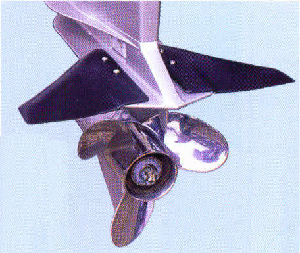







A site dedicated to discussion of these classic boats
25 Sep, 2012
Filed in: customization, parts
 Last year I replaced the ancient 1981 Evinrude 50 that came with my Wahoo! 16.2 with a more powerful and reliable 1995 3 cylinder Johnson 50. After the Evinrude, which was hard to start and tended to stall in idle, it was nice to have an engine that started first or second turn of the key every time. But even with the newer engine I still wasn’t happy with how long it took to get my Wahoo! up on a plane. It took too much throttle to get the nose down. And then once it did come down often the boat was going too fast for conditions (lotsa rocks in Boston Harbor).
Last year I replaced the ancient 1981 Evinrude 50 that came with my Wahoo! 16.2 with a more powerful and reliable 1995 3 cylinder Johnson 50. After the Evinrude, which was hard to start and tended to stall in idle, it was nice to have an engine that started first or second turn of the key every time. But even with the newer engine I still wasn’t happy with how long it took to get my Wahoo! up on a plane. It took too much throttle to get the nose down. And then once it did come down often the boat was going too fast for conditions (lotsa rocks in Boston Harbor).
So I wanted to be able to plane more quickly, with less throttle, and at lower speeds. And I wanted to do it without having to increase horsepower. Following the recommendation of a friend, this spring I looked into adding a hydrofoil to the engine. Researching online I found plenty of back and forth on message boards about the relative merits of hydrofoils.
The cons:
The pros:
And the qualified statements:
Shopping around I found quite a few makes/models to choose from, with prices ranging from $40 to $150. While most hydrofoils require drilling holes in the engine’s cavitation plate (so you can bolt it on), a few of the more expensive models advertised themselves as clamp on/no drilling required. That had some appeal until I read the customer reviews which were generally not favorable.
In the end I opted for Doel-fins, one of the earliest, simplest, and most affordable outboard hydrofoils. I didn’t even have to pay the $40 they cost since I was able to scavenge a set off a boat that that had washed ashore on a local beach and was abandoned by its owner. Installation was easy. It took less than half an hour and drilling holes in the cavitation plates was not the big deal I feared it might be.
Three months of boating later and the verdict is in: What a difference!!! I don’t have exact numbers but I would guess that with the Doel-fins my Wahoo! now achieves a plane at 40% less throttle than it took before. And it now planes at speeds as low as 10-12 mph. The ride and handling are smoother, with nice easy turns and a big reduction in porpoising. And my guess (though I don’t know for sure) is that with the faster planing I’m saving quite a bit of gas.
All in all, couldn’t be happier. ![]()
You must be logged in to post a comment.
I love my stingray hydrofoil, esp since recently adding torque equalizers to the bottom of it. I had a problem with the boat pulling left but after installing these in about 10 mins the steering pull was eliminated. Just thought that might help if anyone was suffering from a similar steering torque issue.
Thanks for the tip Smithhike. This year I found my boat often “leaning left” at medium speeds. This was not so much pull at the steering wheel as a general leaning left of the hull, so maybe it was a weight distribution issue. Still, I’ll add torque equalizers to my list of things to look into this off-season. You didn’t mention adjustment to your outboard’s built in torque trim tab. Did you play with that prior to installing torque equalizers?